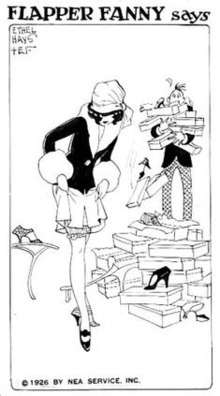Flapper Fanny Says
Flapper Fanny Says was a single-panel daily cartoon series starting on January 26, 1925, with a Sunday page (called Flapper Fanny) following on August 7, 1932.[1] Created by Ethel Hays, each episode featured a flapper illustration and a witticism.[2] The Sunday strip concluded on December 8, 1935; the daily panel continued until June 29, 1940.[1]
| Flapper Fanny Says | |
|---|---|
 Ethel Hays' Flapper Fanny Says original art (1926): "The shoe clerk is often successful because he starts at the foot." | |
| Author(s) | Ethel Hays (1925–1930) Gladys Parker (1930–1935) Sylvia Sneidman (1935-1940) |
| Current status/schedule | Concluded single-panel daily & Sunday strip |
| Launch date | January 26, 1925 |
| End date | June 29, 1940[1] |
| Alternate name(s) | Flapper Fanny |
| Syndicate(s) | Newspaper Enterprise Association |
| Genre(s) | Humor |
At the start, the panel was drawn by notable illustrator Hays, who employed an Art Deco style. Flapper Fanny Says was part of a wave of popular culture that focused on the flapper look and lifestyle. Through many films and the works of illustrators such as Hays, John Held Jr., and Russell Patterson, as well as the writings of F. Scott Fitzgerald and Anita Loos, flappers came to be seen as attractive, reckless and independent.
When Gladys Parker took over the strip in 1930, she gave it a "more cartoony style."[3][4] Focus shifted from Fanny, now a curly-haired brunette resembling Parker herself,[5] to her little sister Betty, a schoolgirl.
Publication history
Because the syndicate Newspaper Enterprise Association often sold whole packages of features to individual newspapers, Flapper Fanny Says gained widespread distribution almost from the start, appearing daily in perhaps 500 papers within its first year.[6]

Despite this immediate success, Hays—finding the daily workload too heavy after the birth of her second child—turned Flapper Fanny Says over to promising newcomer Gladys Parker starting on March 21, 1930.[1] Parker expanded the daily panel into a Sunday strip with the truncated title Flapper Fanny starting August 7, 1932, and continued both until December 8, 1935.[1]
Parker relinquished Flapper Fanny Says to Sylvia Sneidman on December 9, 1935.[1] That artist, who signed her work only "Sylvia," continued the strip until June 29, 1940. Parker began drawing her own creation Mopsy in 1939 (also in her own image).[7]

Flapper Fanny Says was imitated in the Jazz Age by Faith Burrows's similarly themed upstart Flapper Filosofy panel from the rival King Features Syndicate.[8]
Notes
| Wikimedia Commons has media related to Flapper Fanny Says. |
- Holtz, Allan (2012). American Newspaper Comics: An Encyclopedic Reference Guide. Ann Arbor: The University of Michigan Press. p. 152. ISBN 9780472117567.
- 100 Years of American Newspaper Comics: An Illustrated Encyclopedia, edited by Maurice Horn. New York: Gramercy Books, 1996. 413 p., ill. (some col.) -- Includes bibliographical references (p. 405-406). p. 116 ISBN 0-517-12447-5
- Lambiek
- Children of the Yellow Kid: the Evolution of the American Comic Strip / Robert C. Harvey (Seattle : Frye Art Museum, University of Washington Press, 1998). ISBN 0-295-97778-7, p. 58)
- Robbins, Trina. The Great Women Cartoonists. New York: Watson-Guptill Publications, 2001. p. 26.
- Holtz, Allan. "Ethel, Great Female Cartoonist," Hogan's Alley #13 ISSN 1074-7354, Atlanta, Georgia:Bull Moose Publishing Corp., Atlanta GA. "Ethel, Great Female Cartoonist" by Allan Holtz
- "Don Markstein's Toonopedia: Mopsy".
- Guide to the SFACA Collection : Newspaper Comic Strips Series I: Comic Features "Archived copy". Archived from the original on 2008-07-25. Retrieved 2008-12-14.CS1 maint: archived copy as title (link)